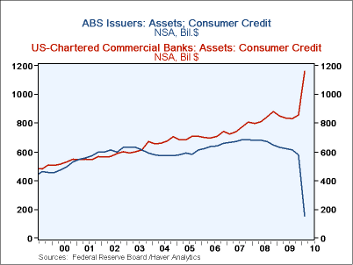 Global| Jun 16 2010
Global| Jun 16 2010New Accounting Rules Shock MBS and ABS Data
Summary
The FASB's new accounting rules 166 and 167 on the use of off-balance sheet accounting for securitized debt issues took effect at the beginning of 2010 for financial institutions with a calendar year fiscal year. From a data user's [...]
The FASB's new accounting rules 166 and 167 on the use of off-balance sheet accounting for securitized debt issues took effect at the beginning of 2010 for financial institutions with a calendar year fiscal year. From a data user's perspective, earlier this year, they were reflected in changes to commercial bank balance sheet data, and last week, with the release of the Q1 Flow-of-Funds data, we saw their impact more broadly on banks, GSEs and the special purpose vehicles (SPVs) these rulings were intended to reform.
It has been routine practice for issuers of securitized debt to "spin" the specific loans and the securities issues off the institutions' balance sheets to a subsidiary set up for the express purpose, an SPV. As FASB's notice explains, this SPV procedure is helpful for financing a narrowly defined project without putting an entire firm at risk. However, the original intention of the SPVs was not to distort the institution's underlying risk profile over a protracted period, which had in fact been happening, as investors found to their dismay during the recent financial crisis. These new rules basically cause the securitized debt issuers to move assets and associated securities liabilities back to their balance sheets.
The following couple of charts show the dramatic impact of the rule
changes on the biggest items.  First, in the mortgage sector, 1-4 family
mortgages that are held at "agency- and GSE-backed mortgage pools"
plunged from $5.27 trillion at the end of 2009 to just $983 billion on
March 31. By contrast, the direct mortgage holdings of the agencies
themselves surged from $438 billion at year-end to $4.75 trillion on
March 31.
First, in the mortgage sector, 1-4 family
mortgages that are held at "agency- and GSE-backed mortgage pools"
plunged from $5.27 trillion at the end of 2009 to just $983 billion on
March 31. By contrast, the direct mortgage holdings of the agencies
themselves surged from $438 billion at year-end to $4.75 trillion on
March 31.
Similarly, among ABS issuers, holdings of consumer credit -- loans and credit card debt -- dropped from $578 billion on December 31 to $152 billion on March 31. The contrast here is at commercial banks, whose balance sheets now show $1,163 billion in consumer credit assets, up from $855 billion at year-end.
 Importantly,
these accounting changes did not affect the transactions generating the
"flows" of credit to either of these borrowing sectors. There were net
new issues of agency mortgage pool securities of $22 billion in Q1 and
net liquidations of $22 billion of consumer debt holdings of ABS
issuers. The Federal Reserve's data is defined as outstanding(t) =
outstanding(t-1) + flow(t) + discontinuity(t), and these accounting
changes are clearly "discontinuities".
Importantly,
these accounting changes did not affect the transactions generating the
"flows" of credit to either of these borrowing sectors. There were net
new issues of agency mortgage pool securities of $22 billion in Q1 and
net liquidations of $22 billion of consumer debt holdings of ABS
issuers. The Federal Reserve's data is defined as outstanding(t) =
outstanding(t-1) + flow(t) + discontinuity(t), and these accounting
changes are clearly "discontinuities".
These data series are contained in Haver's FFUNDS database. The Financial Accounting Standards Board's press release and descriptive material are found here.
Carol Stone, CBE
AuthorMore in Author Profile »Carol Stone, CBE came to Haver Analytics in 2003 following more than 35 years as a financial market economist at major Wall Street financial institutions, most especially Merrill Lynch and Nomura Securities. She has broad experience in analysis and forecasting of flow-of-funds accounts, the federal budget and Federal Reserve operations. At Nomura Securites, among other duties, she developed various indicator forecasting tools and edited a daily global publication produced in London and New York for readers in Tokyo. At Haver Analytics, Carol is a member of the Research Department, aiding database managers with research and documentation efforts, as well as posting commentary on select economic reports. In addition, she conducts Ways-of-the-World, a blog on economic issues for an Episcopal-Church-affiliated website, The Geranium Farm. During her career, Carol served as an officer of the Money Marketeers and the Downtown Economists Club. She has a PhD from NYU's Stern School of Business. She lives in Brooklyn, New York, and has a weekend home on Long Island.





